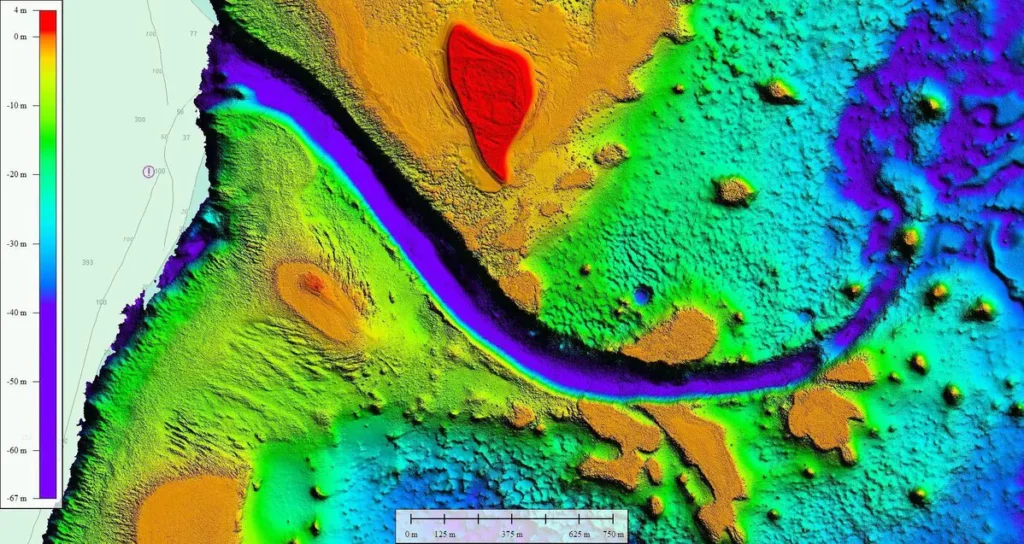Press Release: Many small island nations and states lie at or are just a few metres above sea level. This makes them particularly vulnerable to sea-level rise – homes, infrastructure and lives are all at risk. Our spatial digital twins and lidar technologies are playing a vital role in the development of coastal resilience strategies around the world.
Sea-level rise is one of the most serious consequences of climate change. According to estimates by the Intergovernmental Panel on Climate Change (IPCC), sea levels will keep rising throughout this century, causing increasingly frequent and severe flooding in coastal areas. This is a major cause for concern.
There is no doubt that the lives and livelihoods of communities on many small islands are already in peril. The high coastline-to-land ratio on small islands means that homes, community, industry, critical infrastructure and agricultural land are usually located on or near to the coast.
Indeed, many of these coastal communities have already started to experience the devastating effects of sea-level rise, including the erosion of coastlines and flooding. The island nation of Tuvalu, in the South Pacific, is the canary in the coalmine. Scientists expect that most of Tuvalu’s islands will become uninhabitable by the end of the century – and that many other small islands will share the same fate.
Supporting coastal resilience strategies
To understand the complex risks associated with climate change and sea-level rise, many government agencies and organisations around the world are focusing on developing coastal resilience strategies.
We’ve been doing our bit to help. Two of our technologies have come in very handy: lidar and spatial digital twins.
Lidar
Lidar (light detection and ranging), both topographic and bathymetric, uses laser technology to measure land elevation and sea depth. Combining topographic and bathymetric lidar provides a great way to measure the effects of sea-level rise on small islands. This approach has many benefits:
-
The relationship between land elevation and sea level can be modelled, to inform the design of coastal infrastructure and development planning;
-
Vulnerable areas can be identified, enabling targeted adaptation strategies to be developed;
-
The smallest of changes can be monitored, enabling potential hazards to be identified at the earliest opportunity and mitigation measures swiftly implemented.
This highly accurate lidar data is used to create detailed spatial digital twins and models that are helping scientists to enhance their understanding of the hydrological processes on Tuvalu’s islands, as well as the complex coastal risks.
Spatial digital twins
Spatial digital twins technology combines various sources of Geo-data to provide a detailed understanding of the physical characteristics of coastal environments. The sources may include satellite earth observations, topographic/bathymetric maps and ocean observations from crewed and uncrewed platforms.
Using our digital twin technology, we can present the potential impacts of sea-level rise in a highly visual 3D format. It makes our predictions easier for users to understand. And users can of course drill down to the raw data if they need to access a greater level of detail. These qualities make digital twins ideal for optimising coastal resilience strategies.

Topo-bathymetric lidar of Tuvalu islands in the Pacific Ocean.
“The UNDP Pacific sees the project has benefited the nation enormously. People do not see this benefit coming from LiDAR. Once it is explained to them, then they realise how powerful the data is. One of the main benefits that is yet to be acknowledged is the Prime Minister’s speech at COP26, that 40% of Fogafale’s land area is inundated during King tides. That figure is a direct result extracted from LiDAR data.” says Alan Resture, National Project Manager of the TCAP – UNDP.
Contributing to the global response
November 2022 saw world leaders in government, business and science unite to address the global climate crisis. COP27 provided an important opportunity to promote the urgent need to develop robust adaptation, mitigation, financing and collaboration strategies.
We contributed to many discussions at this pivotal event, including at Blue Zone sessions and Innovation Zone sessions.
Blue Zone sessions
We advised how Geo-data can support resilient cities and coasts. And how it can help to inform measures designed to improve ocean health, for a sustainable ocean economy;
Innovation Zone sessions
We shared our plans to achieve net-zero carbon emissions for our marine operations by 2035. The plans include phasing out large survey vessels and increasing our fleet of smaller uncrewed surface vehicles (USVs).
By rolling out our ever-expanding range of remote and autonomous solutions, more of our expert surveyors and technicians will be able to work from our onshore remote operations centres rather than spending months at sea. This strategy will create opportunities for our workforce to become more diverse and inclusive, with a better work-life balance.
Collaboration is key. Fugro’s coastal lidar capabilities are featured in this video highlighting Tuvalu’s leadership in building resilience to climate change risks. This small island nation is utilising our high-accuracy lidar mapping to implement adaptive measures that will protect their communities and ecosystems from future challenges.
To find out more about any of the topics or technologies mentioned in this feature, contact Dr Pooja Mahapatra (p.mahapatra@fugro.com).































